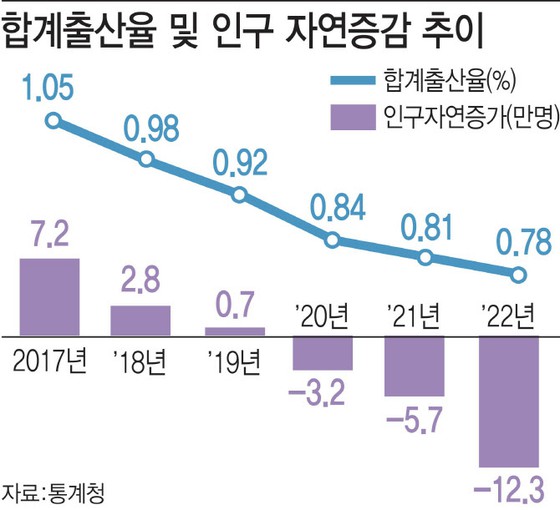 |
Although the number of newborn babies has decreased, the number of deaths has increased rapidly due to the increase in the elderly population and the effects of the COVID-19 virus, and it was found that the population of over 120,000 people, the largest ever, naturally declined over the last year. It is an analysis that the population cliff due to low fertility and the aging population is in full swing.
According to the 2022 Birth and Death Statistics released by the South Korean National Statistics Office on February 22nd, the number of births last year was 249,000, down 4.4% (11,500) from the previous year. The number of births is about half the number in 2012 (484,550) 10 years ago. The total fertility rate stood at 0.78, down 0.03 from the previous year (0.81). Both the number of live births and the total fertility rate were the lowest since the 1970 population statistics were compiled.
South Korea has recorded the lowest total fertility rate among OECD countries every year since 2013. As of 2020, the most recent statistics, South Korea was the only country with a total fertility rate of less than one. Italy, which has the second lowest fertility rate after South Korea, has a total fertility rate of 1.24 in 2020. The OECD average total fertility rate (as of 2020) is 1.59, about twice as high as South Korea.
Last year, South Korea's population naturally decreased by 123,800 (number of deaths - number of births). Only 249,000 babies were born, while 372,800 died. As a result, the Korean population has continued to decline for three consecutive years after the first natural decline in history in 2020. The scale of natural population decline has more than doubled from a year ago (57,118).
Of the 17 regions nationwide, the number of births was less than the number of deaths in all regions except Se Jeong, resulting in a natural population decline. Gyeongsangbuk-do (Gyeongsangbuk-do, 16,500 people) and Busan (Busan, 13,600 people) have seen particularly large population declines, suggesting that the population in rural areas is declining rapidly.
South Korea's population is expected to shrink further in the future due to low birth rates and an aging population. Statistics Korea announced 2021 its future population projections for 2020 to 2070. Over the next 30 years, the number of births in South Korea will fluctuate between 200,000 and 300,000, but by 2055 it will reach 193,000.
At a press conference that day, Prime Minister Han Duk-soo said, "All policies of the Republic of Korea, including education, medical care, pensions, and housing, should be promoted in conjunction with the population crisis. How to get out of this terrible scourge is a consideration."
2023/02/28 09:39 KST


